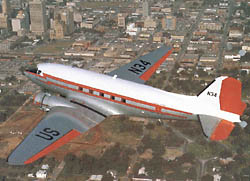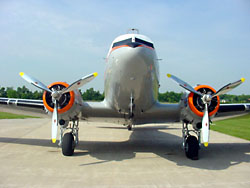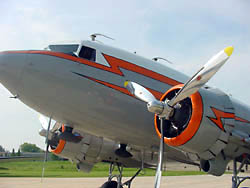
The Douglas DC-3, N34, is a monoplane aircraft built as a TC-47B in 1945 for the U.S. Navy by the Douglas Aircraft Company in Oklahoma City, Oklahoma. It has seen continuous use since then, first as a Navy airplane and later as a transport airplane associated with the Federal Aviation Administration's safety inspection program. The Douglas DC-3, N34 is representative of an aircraft type that revolutionized the commercial airline industry and made a significant contribution to the evolution of military aviation during World War II. First designed and built in the mid-1930s, the first DC-3 flew on December 17, 1935, exactly 32 years after the Wright brothers made the first powered airplane flight. More than10,000 DC-3s were manufactured but only 410 are still registered in the United States, making this airplane a rare survivor of a once common aircraft type. Registered in at least 159 separate countries, the DC-3s were utilized in a vast array of duties from luxury transcontinental passenger transports to crop spraying. General features of Douglas DC-3s include all metal fuselage and cantilevered low wing, all metal vertical and horizontal stabilizer, two reciprocating radial engines, fabric covered control surfaces (ailerons, rudder and elevators) and two main landing gear consisting of wheels and tail wheel. The all-aluminum metal low wing was built in three sections with the stub-wing center section integrated into the lower fuselage; it supports the engines, nacelles and landing gear on each side of the fuselage.

Completed in 1945 near the end of World War II, the Navy used the Douglas DC-3, N34 at various worldwide locations as a transport airplane. Among the assignments were London, Rome, Naples, Paris, Algiers, Frankfort, Brussels, Oslo, Stockholm, Dublin, Cairo, Kuwait and Baghdad. Later converted to a R4D-6, it was assigned to the U.S. Navy Utility Transport Squadron Four (VRU-Four) from February 26, 1947 until March 1949 when it was detached from the squadron and returned to the U.S. On April 8, 1947, N34 nosed over in the mud while being taxied out of the only parking area available in London, and both engines had to be changed. While not officially assigned to the Berlin Airlift (1948-1949), it is highly probable that N34 flew into Berlin in support of Operation VITTLES, as most airplanes in the area during that time were pressed into support of the airlift operation. Sometime prior to 1956 the airplane was put into storage by the Navy.
The Navy loaned the airplane, along with four other DC-3s, to the Civil Aviation Administration (CAA), later the Federal Aviation Administration (FAA). The initial FAA assignment as a flight inspection airplane was to the Southwest Region in Fort Worth, Texas, and later to various other FAA regions. This airplane was operational and photographed with its first CAA livery paint scheme on the ramp at Oakland in August 1958.

n 1981, N34 was withdrawn from flight inspection and assigned to the training program in Oklahoma City, but was declared excess to FAA needs on January 1, 1983. During the early stages of disposing of the DC-3s beginning in the 1970s (as new jets were taking over their functions), initial efforts by FAA employees to preserve one for its historic value finally cumulated in this last FAA DC-3, N34, being reinstated by the FAA Administrator in 1985. Since its 1983 retirement and 1985 restoration, N34 has been used in the FAA's aviation educational programs to promote aviation and the FAA's heritage. The airplane retains the same equipment, furnishings and arrangement that were originally installed in 1957 and is currently being restored so that it can participate in the First Flight Centennial at Kitty Hawk.
Visit the National Park Service Travel American Aviation to learn more about Aviation related Historic Sites.
Last updated: August 22, 2017
